Printer-friendly version (PDF)
Facility Description
 The 9,065-acre site is located in a sparsely populated rural area [i] near the community of De Soto, Kansas and lies within the historical boundaries of the United Tribe of Shawnee Indians lands. The closed facility, now owned by a developer, is situated on a broad ridge with most of the installation lying between two streams which provide habitat for several protected aquatic species. The nearby Kansas River is a state designated drinking water supply.
The 9,065-acre site is located in a sparsely populated rural area [i] near the community of De Soto, Kansas and lies within the historical boundaries of the United Tribe of Shawnee Indians lands. The closed facility, now owned by a developer, is situated on a broad ridge with most of the installation lying between two streams which provide habitat for several protected aquatic species. The nearby Kansas River is a state designated drinking water supply.
 Many of the undeveloped areas of the property have been leased for livestock grazing and hay production. A grazing study identified dioxins/furans in soil and vegetation in non-solid waste management unit areas, some of which were included in current agricultural leases. Although analysis of these data and modeled concentrations in beef indicated a low risk to human health from this pathway, cattle are no longer allowed to graze in these areas. [ii]
Many of the undeveloped areas of the property have been leased for livestock grazing and hay production. A grazing study identified dioxins/furans in soil and vegetation in non-solid waste management unit areas, some of which were included in current agricultural leases. Although analysis of these data and modeled concentrations in beef indicated a low risk to human health from this pathway, cattle are no longer allowed to graze in these areas. [ii]
Historical Open Burning of Contaminated Buildings
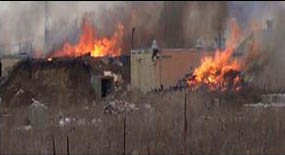 From 1995 to 2005, in preparation for transfer to new owners, the Army at SFAAP burned approximately 1,490 explosives-contaminated buildings and structures[iii] during 142 events.[iv] While federal and state laws prohibit open burning of hazardous wastes, hundreds of buildings were burned without prior removal of asbestos and lead containing materials.[v] Debris, including asbestos from shingles, was carried up to three miles off-site and affecting nearby residential areas.[vi]
From 1995 to 2005, in preparation for transfer to new owners, the Army at SFAAP burned approximately 1,490 explosives-contaminated buildings and structures[iii] during 142 events.[iv] While federal and state laws prohibit open burning of hazardous wastes, hundreds of buildings were burned without prior removal of asbestos and lead containing materials.[v] Debris, including asbestos from shingles, was carried up to three miles off-site and affecting nearby residential areas.[vi]
The Army successfully avoided compliance with National Emission Standards for Hazardous Air Pollutants for asbestos through a loophole in Superfund (CERCLA) law. The Kansas Department of Health and Environment further authorized an exemption from the state’s open burning prohibition.[vii]
At the same time, the U.S. Army Industrial Operations Command acknowledges that open burning of explosive-contaminated structures produces toxic emissions including nitrous oxide. “Open burning will also cause the release of hazardous materials such as asbestos, lead, zinc, and potentially harmful combustion products from electrical materials, preservative coatings on equipment, paints, plastics, and other construction materials into the atmosphere and potentially into soils, groundwater, and surface water,” a 1996 Army report to the State of Kansas confirms.[viii]
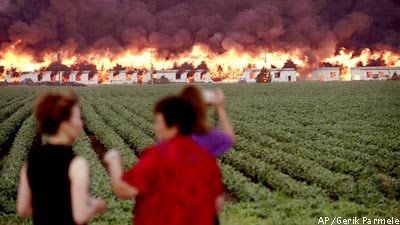 “During an open burning, materials are changed from a solid form and are released to the atmosphere where they will certainly be deposited over a large area resulting in contamination of soil and surface water,” the Army wrote.[ix]
“During an open burning, materials are changed from a solid form and are released to the atmosphere where they will certainly be deposited over a large area resulting in contamination of soil and surface water,” the Army wrote.[ix]
Exposure to airborne vapors and dust generated during burning is also a potential risk to workers and others who might be exposed to toxic emissions and nearby plants and animals; deposited materials could affect both soil and surface water bodies in the area surrounding the burn site, the Army concluded.
Potential Liabilities to Local Government and other parties
 It is currently well-established that historical activities by the U.S. Army caused soil, air, and water contamination at the former Sunflower Army Ammunition Plant. Consultants working for the Army, Kansas Department of Health and Environment, the U.S. EPA, and even the military readily acknowledge that past disposal practices and open burning activities released toxins to the environment.
It is currently well-established that historical activities by the U.S. Army caused soil, air, and water contamination at the former Sunflower Army Ammunition Plant. Consultants working for the Army, Kansas Department of Health and Environment, the U.S. EPA, and even the military readily acknowledge that past disposal practices and open burning activities released toxins to the environment.
If local authorities approve or endorse the current proposal to open burn more than 100 buildings, they could become potentially responsible parties. If, as in the past, nearby residents and properties are negatively impacted, it will no longer be clear that the Department of Defense is solely responsible. There will be no way to differentiate between impacts caused by burns after 2005 and prior burns by the military. Moreover, non-federal entities are often more vulnerable to private legal action.
And while the current proposal to remove readily accessible asbestos, lead, and other hazardous materials will certainly reduce toxic emissions, they will be not be eliminated altogether. The risk assessment for proposed open burning at Wisconsin’s Badger Army Ammunition Plant, for example, requires the same removal precautions yet the State of Wisconsin determined that expected emissions will include: nitrogen oxides, volatile organics compounds, benzene, lead, carcinogenic polycyclic aromatic hydrocarbons (PAHs), formaldehyde, fine particulates, sulfur dioxide, PCBs, and dioxins.[x]
During the course of a burn, heated residual PCBs can form dioxins and furans, a dangerous class of pollutants that are incredibly dangerous to pregnant women and young children even in very small doses. Both PCBs and dioxins are very persistent in the environment, remaining in soils well over 50 years. Both compounds can also accumulate over time in both plants and animals through the food chain.[xi]
Fortunately, there is no timeline at Sunflower binding local decision-makers – contaminated buildings have been there for decades – and there are a number of viable options that can and should be considered.
Examples of Alternative Solutions
(Sources: U.S. Army Environmental Center and U.S. Industrial Operations Command)
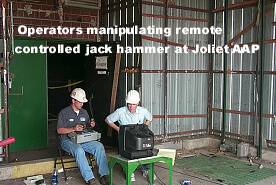 Biological Deactivation or explosives bioremediation involves the addition of bacteria which have been selected from naturally occurring populations for their abilities to metabolize explosives contaminants. This approach is very similar to the bioremediation being used in other areas of Badger to clean up explosive waste in soils and groundwater. The Army reports one company has developed a technology that utilizes a surfactant produced by a specialized group of microorganisms that has the capability to decontaminate buildings, structures and other materials to an “acceptable safe-level”. This system, the military reports, is “non-polluting and should cause no significant damage to building materials or equipment”.
Biological Deactivation or explosives bioremediation involves the addition of bacteria which have been selected from naturally occurring populations for their abilities to metabolize explosives contaminants. This approach is very similar to the bioremediation being used in other areas of Badger to clean up explosive waste in soils and groundwater. The Army reports one company has developed a technology that utilizes a surfactant produced by a specialized group of microorganisms that has the capability to decontaminate buildings, structures and other materials to an “acceptable safe-level”. This system, the military reports, is “non-polluting and should cause no significant damage to building materials or equipment”.
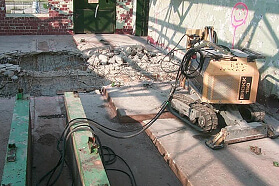 Mechanical “Wet” Demolition/Disposal can be used to demolish buildings that are contaminated with energetics by using heavy equipment that has been modified to protect workers from the effects of potential detonations. Sensitive building demolition using heavy equipment has been performed at Piccatiny Arsenal in New Jersey, the U.S. Industrial Command reports. “The operator compartment and other areas of the vehicle that are susceptible to damage are covered with thick lexan plastic and steel plate to provide protection against explosions. Additional protection is provided by equipping the machinery with extended arms. Prior to beginning demolition, the entire structure is wetted to temporarily deactivate explosive contaminants and to provide dust suppression.”
Mechanical “Wet” Demolition/Disposal can be used to demolish buildings that are contaminated with energetics by using heavy equipment that has been modified to protect workers from the effects of potential detonations. Sensitive building demolition using heavy equipment has been performed at Piccatiny Arsenal in New Jersey, the U.S. Industrial Command reports. “The operator compartment and other areas of the vehicle that are susceptible to damage are covered with thick lexan plastic and steel plate to provide protection against explosions. Additional protection is provided by equipping the machinery with extended arms. Prior to beginning demolition, the entire structure is wetted to temporarily deactivate explosive contaminants and to provide dust suppression.”
- Demolition by explosives is “routinely used to demolish buildings”. Debris is removed by armored heavy equipment with extended mechanical arms and debris is often landfilled. Implosion is currently being discussed as a non-thermal alternative for some buildings at Wisconsin’s Badger Army Ammunition Plant.
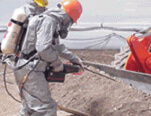 Chemical Deactivation involves several steps including wetting, sodium hydroxide and possible organic solvent addition, solvent recirculation, solvent collection and disposal and neutralization. “To control the process and minimize potential for releases of chemicals to the environment, temporary containment measures are used to prevent water and chemicals from draining to surrounding soils or nearby waterways. All drains from the building are plugged and a sump or low point (either existing or installed) is used to collect excess liquids. A water/chemical distribution system with spray nozzles is installed inside and outside the building but within the enclosure,” the Army said.
Chemical Deactivation involves several steps including wetting, sodium hydroxide and possible organic solvent addition, solvent recirculation, solvent collection and disposal and neutralization. “To control the process and minimize potential for releases of chemicals to the environment, temporary containment measures are used to prevent water and chemicals from draining to surrounding soils or nearby waterways. All drains from the building are plugged and a sump or low point (either existing or installed) is used to collect excess liquids. A water/chemical distribution system with spray nozzles is installed inside and outside the building but within the enclosure,” the Army said.
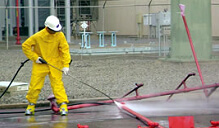 Waterblasting is a mechanical removal method that uses a 500-20,000 psi water jet to remove contaminated surfaces. According to the U.S. Army Environmental Center, “explosives-contaminated materials are routinely decontaminated to above 99.9% levels using methods such as pressure washing or stream cleaning”.
Waterblasting is a mechanical removal method that uses a 500-20,000 psi water jet to remove contaminated surfaces. According to the U.S. Army Environmental Center, “explosives-contaminated materials are routinely decontaminated to above 99.9% levels using methods such as pressure washing or stream cleaning”.
- Enclosed burning employs a pre-manufactured portable enclosure that can be placed over the building to be burned. Emissions are ducted to an incinerator/afterburner system intended to capture particulates and combustion products.
- Hot Gas Decontamination provides a rapid, cost effective method to achieve required removal efficiencies, according to military sources. The United States Army Environmental Center reports that it has sponsored demonstrations that show that 99.9999% decontamination of structural components is possible using heated gas to thermally decompose or volatilize explosives or chemical agents, with destruction of off-gases in a thermal oxidizer. The hot-gas process was effective for treatment of items contaminated with explosives, USAEC reported.
- Inerting of Explosives is effective in desensitizing explosives to allow “safe access to sensitive buildings and equipment”, the Army reports. “Wetting with water, will desensitize most explosives including NC (nitrocellulose). Agents which desensitize and inactivate can be mixed and then applied in the same treatment.” While this approach is not considered a decontamination technique, it is a useful strategy to allow safe access for workers, the military said.
This list is presented to illustrate the range of potential alternatives to open burning and does not necessarily imply an endorsement of a specific technology by CSWAB.
For more information contact:
Citizens for Safe Water Around Badger (CSWAB)
E12629 Weigand’s Bay South, Merrimac, WI 53561
Phone: (608) 643-3124
E-mail: info@cswab.org
**********************
[i] U.S. Army, Sunflower Army Ammunition Plant, About Sunflower, undated.
[ii] U.S. Environmental Protection Agency, Region 7, National Priorities List Fact Sheet for Sunflower Army Ammunition Plant, November 28, 2005.
[iii] Environmental Assessment for Building Demolition and Explosives Decontamination for the former Sunflower Army Ammunition Plant, De Soto, Kansas, Sunflower Redevelopment, LLC., February 2006.
[iv] Kansas Department of Health and Environment, Memorandum, Subject: Potential Asbestos and Lead Releases to Residences Adjacent to Sunflower Army Ammunition Plant, site file #C4 046 00052-1, July 17, 2001.
[v] U.S. Environmental Protection Agency, Region 7, Letter to U.S. Senator Sam Brownback, November 4, 1998.
[vi] Kansas Department of Health and Environment, Memorandum, Subject: Potential Asbestos and Lead Releases to Residences Adjacent to Sunflower Army Ammunition Plant, site file #C4 046 00052-1, July 17, 2001.
[vii] Kansas Department of Health and Environment, Consent Order in the Matter of Pollution at Sunflower Army Ammunition Plant, July 10, 2001 http://www.propertydisposal.gsa.gov/mip/army/sunflower/pdf/consent_agreement.pdf
[viii] U.S. Industrial Operations Command, Risk Analysis and Environmental Stabilization plan for Excess Personal Property Sunflower Army Ammunition Plant (final), prepared by Plexus Scientific, Contract Number DAAA09-95-G-0011, Task Order #001, July 29, 1996.
[ix] U.S. Industrial Operations Command, Risk Analysis and Environmental Stabilization plan for Excess Personal Property Sunflower Army Ammunition Plant (final), prepared by Plexus Scientific, Contract Number DAAA09-95-G-0011, Task
Order #001, July 29, 1996.
[x] Wisconsin Department of Natural Resources, Analysis, Preliminary Determination and Draft plant for Badger Army Ammunition Plant (for explosives decontamination and demolition of buildings), February 23, 2003.
[xi] Overview and Evaluation of Risks: Proposed Open Burning of Contaminated Buildings at Badger Army Ammunition Plant, Dr. Peter deFur, Environmental Stewardship Concepts, April 2006.

